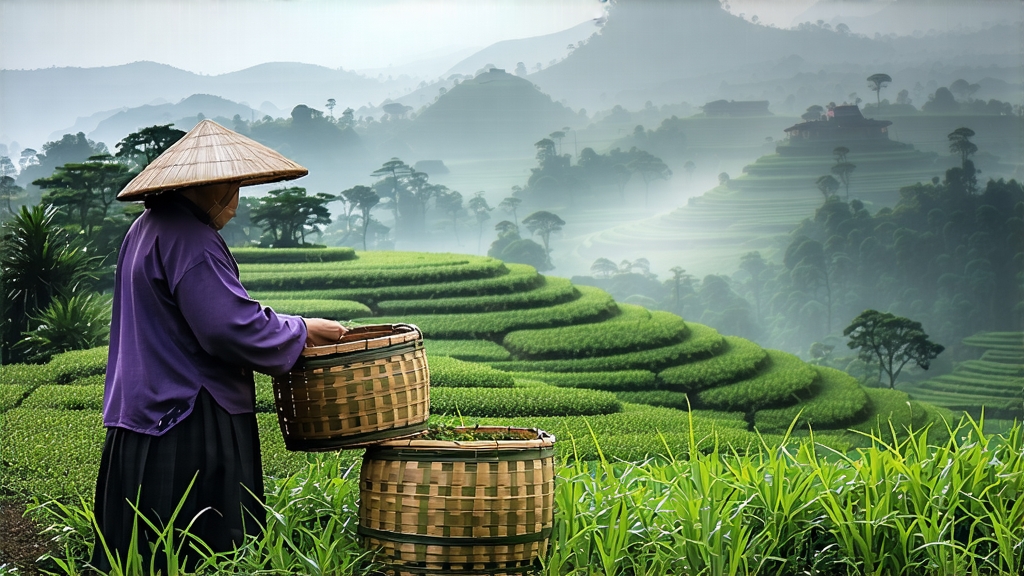
If you ask Chinese tea historians to name the moment when black tea was born, most will point to the Wuyi Mountains of northern Fujian around the mid-17th century. There, pressed against jagged cliffs veiled in perpetual cloud, monks and farmers first allowed freshly picked leaves to wither, roll, ferment, and then—almost by accident—dry over smouldering pine fires. The result was Lapsang Souchong, a tea whose very name carries the echo of its origin story: “souchong” refers to the fourth and fifth leaves traditionally used, while “Lapsang” (Le Shan in local dialect) evokes the high, precipitous passes where the smoke curled upward toward the sky.
From this rugged cradle, Lapsang Souchong travelled down the Min River to the port of Xiamen, caught the monsoon winds to Java, rounded the Cape of Good Hope, and arrived in London coffee-houses just as the English were discovering their national obsession with tea. Samuel Pepys wrote of tasting “a cup of the new Bohee” in 1667; the East India Company’s ledgers soon listed “Lapsang Souchong” at prices higher than silver. In the bargaining pidgin of Canton, “Bohea” became the generic word for all black teas, but connoisseurs knew the smoked leaf from Tongmu Village was the true aristocrat.
Today the tiny Tongmu gorge—barely seven kilometres long—remains the only place where authentic Lapsang Souchong is made. Chinese law protects the name as a geographical indication, shutting out the caramel-coloured, artificially flavoured imitations that once flooded supermarket shelves. Within the gorge, thirteen registered family workshops still follow the 400-year-old protocol.
The harvest begins in late April, when the mountain air is cool enough to keep the leaf supple. Standard pluck is one bud with two or three leaves, tougher than the tender tips used for green tea because the final smoking will mellow any coarseness. After picking, the leaves are laid on bamboo mats in the upper storey of wooden houses whose windows are opened only at night; the mountain breeze brings the temperature down to 18 °C and humidity to 65 %, ideal for a slow 8–10 hour wither. Masters judge readiness by touch: a leaf must crackle yet not snap, curling at the edges like a parchment page.
Rolling comes next, but not the violent maceration of CTC teas. Instead, the leaves are placed in a shallow bamboo drum mounted on a tilted axis. A craftsman turns the crank for twenty minutes, allowing the cell walls to bruise just enough for oxidative enzymes to meet air. The fragrance shifts from grassy to something reminiscent of ripe apricot.
Fermentation, the enzymatic oxidation that turns green leaf coppery, is done in giant pine crates lined with wet cloth. Temperature is held at 24 °C; every thirty minutes the tea master lifts a handful to the light, watching for the tell-tale mahogany rim that signals completion. At precisely 80 % oxidation—any more would flatten the cup—leaves are spread on iron trays and carried to the firing room.
Here lies the signature step: smoking over resinous pinus massoniana. The floor is a lattice of brick channels; beneath it, pine logs smoulder without flame, their smoke drawn upward by a natural chimney effect. Trays are stacked five high, and for the next six hours the leaves absorb the aromatic volatiles—guaiacol, syringol, creosol—that will later translate into the tea’s celebrated notes of pine sap, smoked apricot, and winter campfire. Yet the goal is balance: too short a smoke and the tea tastes hollow; too long and it becomes a kipper. Masters listen for the moment when the crackle of leaves softens to a whisper, then rush the trays to a charcoal oven for a final 90-second bake that sets the flavour.
The finished tea is sorted by hand into four commercial grades.
- Zheng Shan Xiao Zhong—pure bud, smoked only two hours, yielding a golden liquor with hints of longan and a whisper of pine.
- Special Lapsang—bud and first leaf, balanced smoke, the grade most often found in specialty shops abroad.
- King Lapsang—larger leaf, deeper smoke, favoured by Russian samovar drinkers who sweeten it with cherry jam.
- Tongmu Old Bush—harvested from 150-year-old wild